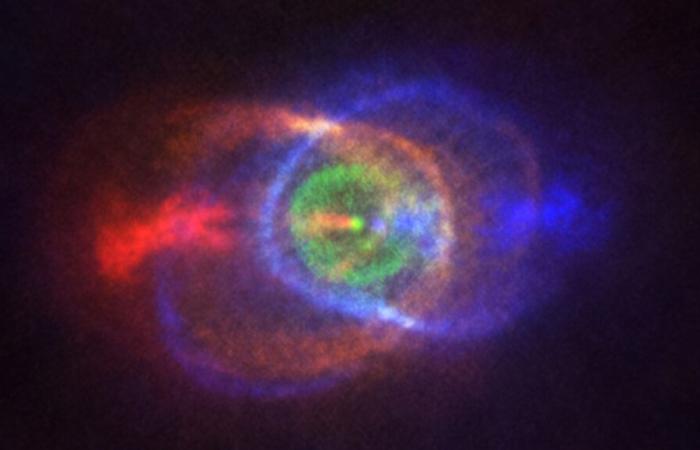HD 101584, pair of dying stars sharing the same gaseous envelope.
© ALMA (ESO / NAOJ / NRAO), Olofsson et al
The life and death cycle of stars is today very well understood by the community of astrophysicists. Certain phases are nevertheless more obscure and understanding them better is essential when we consider that all of the complex elements of the Universe, the atoms heavier than hydrogen and helium, are synthesized by the stars. The carbon in our body, the oxygen we breathe, the iron in our blood and our tools, the gold in our jewelry: all this material comes from the hearts of stars or from their envelopes when they explode in supernovas .
Advertising, your content continues below
The detailed understanding of each stage of the existence of stars is therefore a major challenge in our quest for knowledge of Nature and the Cosmos. A particularly beautiful and mysterious phase has just been studied by finding binary stars, that is to say forming a couple, so close together that they orbit in a common gas envelope, almost a shroud. This is what the couple HD 101584 looks like in visible light and surrounded by its nebula, all imaged using NASA’s Hubble space telescope.
The couple HD 101584 and its nebula seen by Hubble.
© Nasa / ESA Hubble Space Telescope
Here is another stellar couple, including a white dwarf, responsible for a sculptural nebula.
Advertising, your content continues below
Fleming 1, nebula shaped by the very close orbit of two suns, including a white dwarf.
© ESO
Still captured by Hubble, NGC 2346 is another nebula formed in the constellation Unicorn by these pairs of stars in very tight orbits.
NGC 2346, nebula sculpted by the very close orbit of two stars, including a dwarf star.
© Nasa/ ESA Hubble Space Telescope
These pairs of stars will become explosive “cataclysmic variables”!
The fate of this type of sun is fascinating. When its still “living” component, that is to say still merging atoms in its heart, reaches its final stage, that of a red giant star, its diameter will increase by a factor of 100, or even 1000. However, both stars will be so close to each other that the smallest – and dense – will periodically tear off matter from its “dilated” – therefore less dense – giant companion. When this material falls, it will cause thermonuclear explosions! This is the next phase in the evolution of these stellar duos, called “cataclysmic variables”.
And although so-called binary stars are very common in the Universe, it is not so easy to find these particular pairs sharing a common envelope. Here, scientists managed to identify 52 serious candidates spread across 38 open star clusters in the Milky Way. Among these open clusters, the most famous is that of the Pleiades, located 444 light years from Earth.
The famous Pleiades open cluster.
© Mount Palomar Observatory
Having isolated candidates for this phase of cataclysmic variables, both beautiful and exciting from a scientific point of view, will allow important theoretical advances according to Steffani Grondin, lead author of the study: “This observational sample marks a key first step in allowing us to follow the entire life cycles of binaries. And, hopefully, it will allow us to better constrain the most mysterious phase of stellar evolution.”
Research made possible thanks to the automatic learning of artificial intelligence
The co-author of the study, Joshua Speagle, specifies that artificial intelligence “also made it possible to automate searches on hundreds of clusters. A task that would have been impossible if we tried to identify these systems manually.”
This new sample will allow us to develop our knowledge related to supernovae 1a (a type occurring in binary systems with at least one white dwarf, the other sun can be of any type), nucleosynthesis and waves gravitational.
Sources :
Phys.org
The Astrophysical Journal
Advertising, your content continues below






